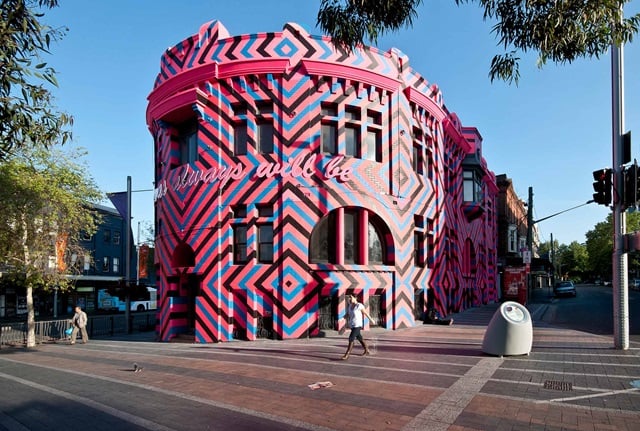


Reused locally quarried sandstone is repurposed with carvings describing the diversification of the community through food.
Artwork description
Outcrop Esculentus Spiralis features 12 pieces of sandstone. They range from small rectangular blocks to larger curves of coping, lying partially embedded in the park’s central elliptical lawn. Engraved in each block is a botanical drawing of a plant that has been eaten by the local community at some time in the past 200 years. The sculpture uses sandstone which was quarried on the Pyrmont Peninsula last century and was previously part of the Pyrmont Bridge.
The blocks radiate from a central peak to make an approximate circle 10m in diameter. The diet of local Indigenous groups and the settlement of English, European, Chinese, Mediterranean and Southeast Asian are all reflected in the engravings. These include bracken root, banksia nectar, wheat, mint, ginger, grapes, corn, peas, olives, cabbage, mushroom and garlic. The variety of plants indicates how the community has diversified by observing the change in diet.
The title Outcrop Esculentus Spiralis holds layers of possible meanings. Initially the notion of an outcrop of rocks in a landscape is evident. Isolating the crop makes reference to the botanical drawings. Esculentus spiralis uses Latin botanical language, describing the work, instead of a plant, to be edible, and spiralling out.
Artist
Lucy Bleach’s practice focuses on humanity’s enduring relationships to volatile environments by engaging with communities that directly experience such interactions and with scientists who monitor the earth’s motion.
Bleach generates artworks where processes are contingent on geological force and which anticipate their own ensuing instability and trandformation. She works across sculptural forms, living elements, sound, light and moving image. Bleach also uses her practice to initiate unpredictable outcomes, investigate transitions of matter, and slow the process of material collapse.
Bleach’s practice spans curated exhibitions, festival commissions, community collaborations, curatorial projects, published writing and lecture presentations. She has produced solo commissioned and collaborative works, exhibited nationally and internationally, and undertaken research projects in geologically unstable regions in Italy, Japan, Hawaii and Vanuatu.







